#146: Gliophorus psittacinus, the Parrot Mushroom
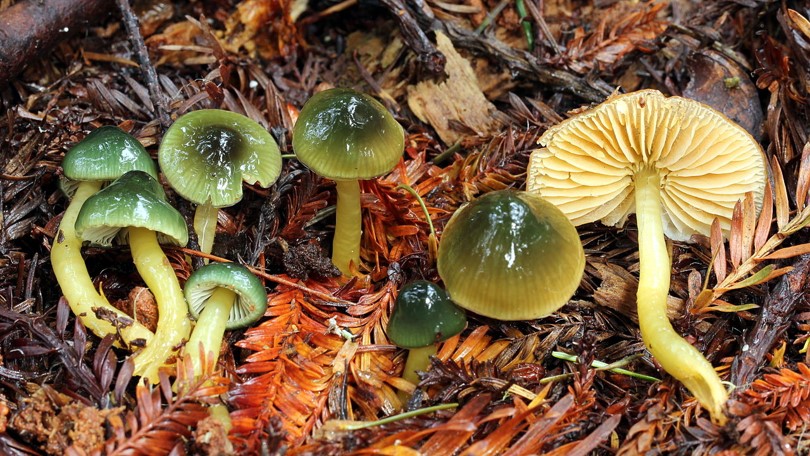
Gliophorus psittacinus, the Parrot Mushroom, is easy to identify based on its green color (at least when young), slimy stipe, and slimy gills. Photo by Alan Rockefeller [CC BY-SA 3.0], via Wikimedia Commons.
Description
G. psittacinus is a small umbrella-like mushroom with a hemispherical to flat pileus and a central stipe. The mushroom grows to between 1 and 4cm tall and produces a pileus 0.5 to 3cm in diameter.1 North American West Coast specimens tend to be larger, growing 4-9cm tall and 1.5-4cm across.3 European mushrooms are somewhere between the two with dimensions of 3-6cm tall and 1.5-4cm wide.2,4
The pileus is the most readily seen and most striking part of the mushroom. It starts out small and hemispherical but expands to become convex or nearly flat. At first, the pileus is very slimy and dark green. Although the color is somewhat variable, most mushrooms start out some shade of green. This color quickly fades, however, and the cap takes on a yellow to orange hue. The fading starts at the center of the cap, so mature specimens often retain some of their green color around the edges. The pileus margin also frequently displays faint lines that trace the gills underneath.1–3
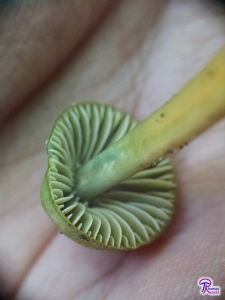
Like the rest of the mushroom, the Parrot Mushroom’s gills start out green but fade to yellow as the mushroom ages.
Underneath the pileus, the mushroom forms gills that start out pale green but become yellowish or orange-yellow as they mature. Exactly when in development this change takes place varies between individuals, so the gills may already be yellow in some young specimens. The gills are attached, although they may run down the stipe some or recede from the stipe slightly. Parrot Mushrooms frequently produce short-gills, which start at the cap’s margin but do not run all the way to the stipe. Despite the gills’ coloration, the mushroom produces a white spore print.1–3
The stipe supporting the mushroom is only a few millimeters thick and stays roughly the same thickness for its entire length. It is colored and textured like cap. The stipe starts out green and fades to yellow or orange from the bottom up. Older specimens occasionally keep some green at the top of the stipe, but most of the time the stipe fades completely to yellow. As with the cap, the stipe is smooth and quite slimy. Inside the stipe, the flesh is waxy and whitish with tones of yellow and green and surrounds a small hollow area at the center of the stipe.1–3
Ecology
The Parrot Mushroom can be found in North America and Europe growing gregariously on the ground in a variety of habitats.1–3 In Europe, the mushroom favors acidic or neutral grasslands that have not been fertilized.2 In North America, it prefers forests of either hardwoods or conifers.1,3 On both continents, it is often found growing in moss and/or along roadsides. G. psittacinus produces mushrooms from spring through fall or over winter in warmer climates.1–3
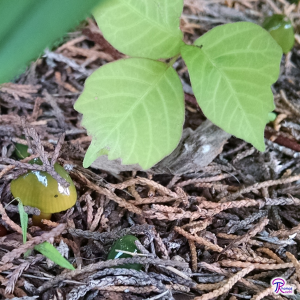
The Parrot Mushroom often appears in moss, but I’ve never found it in particularly mossy areas. Available moisture (found in the mulch in this picture) seems to be a more important factor than moss.
Waxcaps are traditionally considered saprobic, but they also seem to have some kind of mutualistic relationship with mosses.1,2 So far, I have found G. psittacinus in mulch and along a wooded stream bank. Neither of these places had much (if any) moss, so maybe availability of moisture is more important than plant relationships.
Similar Species
G. psittacinus is a rather variable species and may actually be a species group. In North America, at least, it seems likely that multiple species are hiding inside the mushroom’s current definition.1,5 Mycologists have yet to tease out any of these species, so for the moment they are all called G. psittacinus and the larger distinctions are separated out into varieties.1,3 European authors recognize three varieties: G. psittacinus var. psittacinus, which is the normal variety, G. psittacinus var. perplexa (sometimes separated out as its own species, Gliophorus perplexus), which does not have any green color at the top of its stipe, and G. psittacinus var. albietina, in which the green tones are more even and longer-lasting.2,4 North America has a unique variety: G. psittacinus var. californicus (although this name isn’t official due to procedural red tape). This version starts out blue and becomes red as it matures.6
Older Parrot Mushrooms can easily be mistaken for many other smallish, yellow waxcaps. This can make them very hard to identify down to species. Frequently, traces of green can be found on the caps of mature mushrooms, which helps simplify identification.1,2
There are two other species of green-capped waxcaps in North America: Hygrocybe chlorochlora and Hygrocybe virescens. Both species are found in the Caribbean and Mexico and have a stipe that is dry to moist but never slimy. H. chlorochlora has a mostly yellow stipe while H. virescens has a mostly green stipe.7
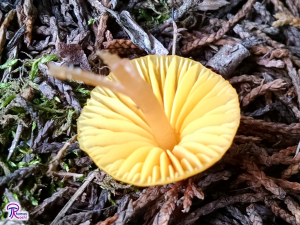
It’s hard to get good pictures of the Parrot Mushroom. I usually see the yellow stage first and either ignore the seemingly boring mushroom or manhandle it before realizing what it is.
Edibility
G. psittacinus is listed as edible in most field guides, although some label it mildly poisonous.3,4 Of course, it would take hundreds of Parrot Mushrooms to make a decent-sized dish. Thanks to its small size, rarity, and unappealing texture, nobody bothers to collect and cook this mushroom. In Europe, mycologists go one step further; they recommend against eating G. psittacinus because the mushroom is very rare and they therefore want to discourage collection for consumption.2
Taxonomy
This fungus may be found listed under a few different names because it has been shuffled around between a number of genera over the years. Two common synonyms for G. psittacinus are Hygrocybe psittacina and Hygrophorous psittacinus.1,2 Hygrocybe and Hygrophorous are the two main genera of waxcaps, so either name would seem reasonable. The mushroom was moved to its current genus in 2013, which means many publications still list it under one of its older names.1 Among the waxcaps, the genus Gliophorus presumably diverged from the Hygrophorous lineage, making it more closely related to Hygrophorous than to Hygrocybe. However, the evolutionary branches of the waxcaps are not very well defined, so the genus’ exact placement in the lineage is still up for debate.5
| Kingdom | Fungi |
| Division (Phylum) | Basidiomycota |
| Subdivision (Subphylum) | Agaricomycotina |
| Class | Agaricomycetes |
| Subclass | Agaricomycetidae |
| Order | Agaricales |
| Family | Hygrophoraceae |
| Genus | Gliophorus |
| Species | Gliophorus psittacinus (Schaeff.) Henrik8 |
This post describes a group of mushrooms and as such the information on this page (including the pictures) cannot be used to identify any mushroom in particular.
This post does not contain enough information to positively identify any mushroom. When collecting for the table, always use a local field guide to identify your mushrooms down to species. If you need a quality, free field guide to North American mushrooms, I recommend Michael Kuo’s MushroomExpert.com. Remember: when in doubt, throw it out!
Do not use information in this post to self-diagnose or self-treat a medical complaint. Always consult a licensed medical doctor for proper diagnosis and treatment of a health issue.
See Further:
http://www.first-nature.com/fungi/hygrocybe-psittacina.php
http://www.mushroomexpert.com/gliophorus_psittacinus.html
http://www.mykoweb.com/CAF/species/Gliophorus_psittacinus.html
http://champyves.pagesperso-orange.fr/champignons/fichier_htm/lames/Hygrocybe_psittacina.html (in French)
Citations
- Kuo, M. Gliophorus psittacinus. MushroomExpert.Com (2014). Available at: http://www.mushroomexpert.com/gliophorus_psittacinus.html. (Accessed: 15th March 2018)
- O’Reilly, P. Gliophorus psittacinus (Schaeff.) Herink – Parrot Waxcap. First Nature Available at: https://www.first-nature.com/fungi/gliophorus-psittacinus.php. (Accessed: 15th March 2018)
- Wood, M. & Stevens, F. California Fungi—Gliophorus psittacinus. The Fungi of California Available at: http://www.mykoweb.com/CAF/species/Gliophorus_psittacinus.html. (Accessed: 15th March 2018)
- Bernoux, J. Y. Hygrocybe psittacina (Schaeffer : Fr.) Kummer: Hygrophore perroquet. ChampYves: le site aux mille champignons (2008). Available at: http://champyves.pagesperso-orange.fr/champignons/fichier_htm/lames/Hygrocybe_psittacina.html. (Accessed: 15th March 2018)
- Lodge, D. J. et al. Molecular phylogeny, morphology, pigment chemistry and ecology in Hygrophoraceae (Agaricales). Fungal Diversity 64, 1–99 (2014).
- Kuo, M. Gliophorus species 01: Hygrophorus psittacinus var. californicus. MushroomExpert.Com (2014). Available at: http://www.mushroomexpert.com/gliophorus_sp_01.html. (Accessed: 16th March 2018)
- Kuo, M. The Waxy Caps (MushroomExpert.Com). MushroomExpert.Com (2014). Available at: http://www.mushroomexpert.com/hygrophoraceae.html. (Accessed: 15th March 2018)
- Gliophorus psittacinus (Schaeff.) Herink, Sb. severočesk. Mus., Hist. Nat. 1: 82 (1958). Index Fungorum Available at: http://www.indexfungorum.org/names/NamesRecord.asp?RecordID=103376. (Accessed: 15th March 2018)

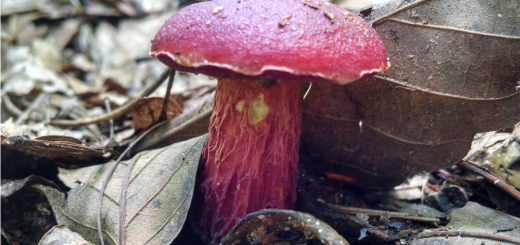






![#011: Characteristics of Kingdom Fungi [Archived]](https://www.fungusfactfriday.com/wp-content/themes/hueman/assets/front/img/thumb-small-empty.png)

i would like to know what it needs to survive please no websites will tell me
This is not completely known in G. psittacinus. We assume it decays organic matter (leaves, sticks, etc.) but it might also be involved in some kind of nutrient exchange with moss. So, to survive it probably needs some organic compounds in the form of leaves, sticks, and/or humus, water, oxygen, and maybe some living mosses.